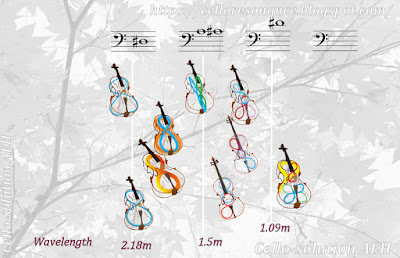[ 4/11/2021 ] [ 4/12/2021 ] Labels : 04.Basic Study
Typical resonance orbits in the cello body were studied over 15 semitones from D(147Hz) to E(331Hz).
Basically, the orbit seems taking a '8'-shape route. 4/4-fullsize cello takes a pure 1-beat route along the bouts-wall at around D#(147Hz, wavelength =orbit-length = 2.18m). According to shift to higher tones the 8-shape becomes thinner then separates to independent two 8-shape groups at around D#(313Hz). The silhouettes of the two D# fit well.
Traditional violin makers had been probably looking for the ideal instrument that can resonate to any given pitch continuously, in the end they invented such a 8-shape body (paying for a risk of interference).
Additional studies will be done by targeting high tones and mainly low tones. At these areas, the resonance might be easily affected by the endpin's characteristic behavior.
D(147Hz)から E(331Hz)まで約1オクターブ(半音15個)の共鳴軌道を考察してきた。この間、共鳴ルートは基本的に8の字形の軌道をとっているように見える。多分、弦によって叩かれ筐体の空間を圧縮するのが表板の8の字形状であることに依存していると考えられる。おそらく3回も圧縮を繰り返せば(=3周期くらいで)そのルートは決まり、周期・波長・ピッチが決まるに違いない。
156HzのD#付近では側壁(Bouts)に沿ったピュアな1ビートが見られ、その後A(221Hz)に向けて8の字が細くなり、A#-D#(295Hz)あたりでは8の字が連結して(3つのチェーン化)してルートを作っていると考えられる。オクターブ上のD#(313)以高では2つ(2グループ)の独立した8の字に分離するように見える。この時波長は1/2となるが、筐体を1/2に縮小したシルエットがちょうど4/4のもとのシルエットに収まるようになる。
昔、ストラディバリウスをはじめとするバイオリン製作者たちは「あらゆるピッチに対して連続して共鳴できる理想の楽器を作ろうとしてこの8の字形の筐体を発明したのではないかと思われる。しかしこの「究極のデザイン」を手に入れた代償として 付きまとう「干渉」を許容した。これがバイオリン属の楽器であろう。
これより高音域では益々8の字は自由・多様に姿を変えるはずである。逆にこれ以下の低音域では2度・3度とループすることで長周期を作り出すはずである。
しかし、高音域・低音域ともに筐体に取り付けられたエンドピンが実はチェロの共鳴(響き)に大きく影響することになる。
エンドピンの影響を比較しながら、引き続き低音域を中心にチェロの響きの挙動を観察していこう。


